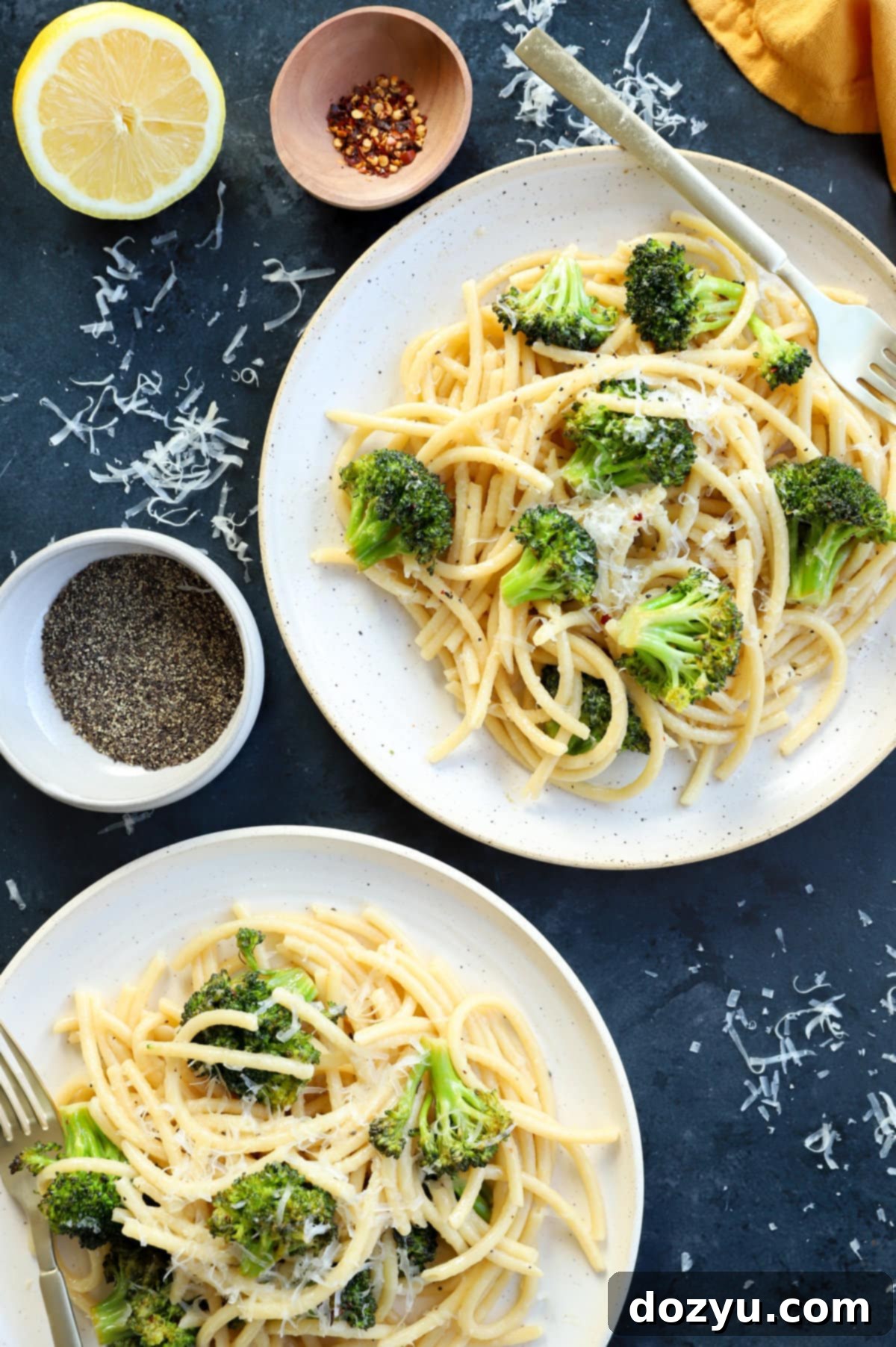Bucatini Cacio e Pepe with Roasted Broccoli: A Creamy, Peppery Roman Pasta with a Fresh Twist
Bucatini Cacio e Pepe with Roasted Broccoli transforms the iconic Roman pasta – celebrated for its minimalist perfection of cheese and pepper – into a vibrant, well-rounded meal by incorporating tender, zesty vegetables. The sauce, an emulsion of Pecorino Romano or Parmesan, freshly cracked black pepper, and starchy pasta water, achieves an unparalleled creamy richness that is both comforting and sophisticated. This recipe promises a truly delectable, quick, and easy dinner that will captivate everyone at your table with its bold flavors and irresistible texture.
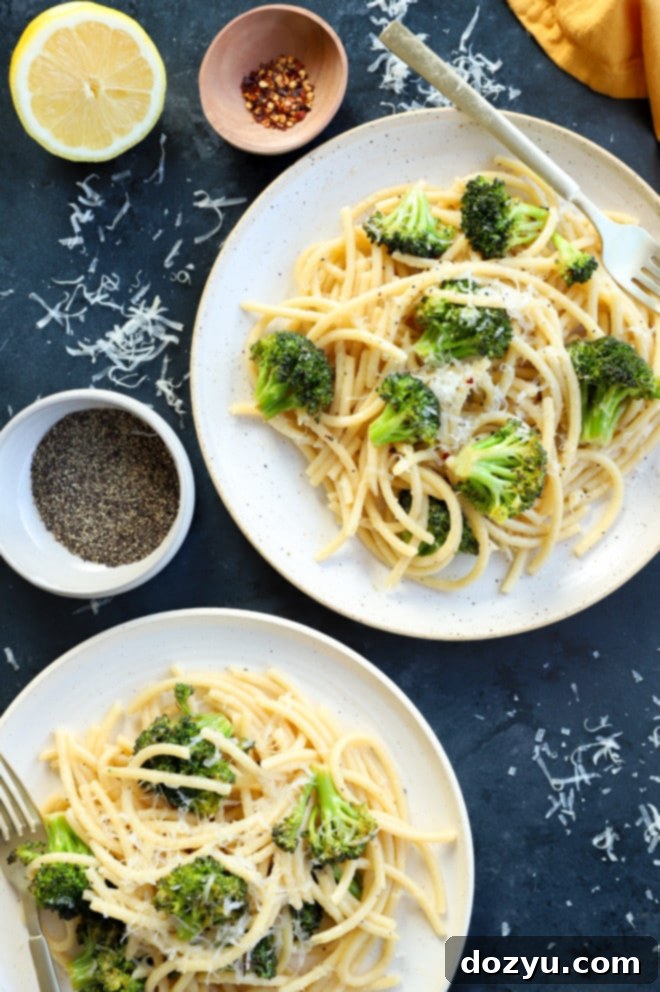
table of contents
Toggle
About This Bucatini Cacio e Pepe with Broccoli
The first time I attempted to make cacio e pepe, I thought its simple ingredient list meant an easy execution. Boy, was I wrong! Much like my early disastrous foray into carbonara, I impulsively dumped all the cheese in at once, expecting a magical, glossy sauce to appear. Instead, I was met with a clumpy, unappetizing mess that disheartened me from trying again for years. This seemingly straightforward Roman dish, as I quickly learned, demands respect for its technique.
After seeing countless mouth-watering photos from friends exploring Italy, my determination to master this classic reignited. What I discovered is that cacio e pepe isn’t inherently difficult; it simply requires adherence to specific, yet simple, instructions. The magic lies in the method. Once you understand the nuances, it transforms from a daunting challenge into an incredibly rewarding culinary experience.
This particular Bucatini Cacio e Pepe recipe offers a delightful and thoughtful twist on the traditional. While the classic stands perfect on its own, I’ve found that adding roasted broccoli elevates the dish, bringing a fresh dimension to its rich flavors. The broccoli is tossed with lemon juice and a hint of red pepper flakes before roasting. This preparation infuses it with a bright, acidic zing and a gentle warmth that beautifully complements the creamy, peppery, and cheesy pasta. It creates a harmonious contrast, cutting through the richness and adding a lovely textural element.
I personally love incorporating vegetables directly into my pasta dishes, making it a complete meal in one bowl. However, if you’re a purist or simply prefer your greens on the side, feel free to omit the broccoli entirely. The cacio e pepe sauce itself remains true to its Roman roots, delivering that unforgettable, robust flavor that keeps you coming back for more.
What is Bucatini Cacio e Pepe?
Cacio e Pepe, meaning “cheese and pepper” in Roman dialect, is one of the most beloved and ancient pasta dishes hailing from Rome. It’s a testament to the power of simplicity, relying on just a few high-quality ingredients to create a profoundly flavorful and satisfying meal. Historically, this dish was a staple for shepherds in the Roman countryside, as its ingredients (dried pasta, hard cheese, and black pepper) were non-perishable and easy to transport.
At its heart, Cacio e Pepe is an emulsified sauce, meticulously crafted from finely grated Pecorino Romano cheese (or sometimes Parmesan), an abundance of freshly ground black pepper, and the starchy water left over from cooking the pasta. When combined correctly, these three elements transform into a lusciously creamy, glossy sauce that clings perfectly to every strand of pasta. There’s no cream, no olive oil (traditionally), and no egg – just pure, unadulterated flavor derived from simple, humble components.
The beauty of this Roman pasta dish lies in its ability to highlight the individual characteristics of each ingredient. The sharpness of the cheese, the pungent warmth of the pepper, and the satisfying chew of the pasta all come together in a symphony of taste and texture. Our version uses bucatini, a thick, hollow spaghetti-like pasta that’s perfect for capturing the creamy sauce within its tube and on its surface. Adding the bright, slightly spicy roasted broccoli creates a fresh and modern interpretation of this timeless classic, making it even more appealing as a complete meal.
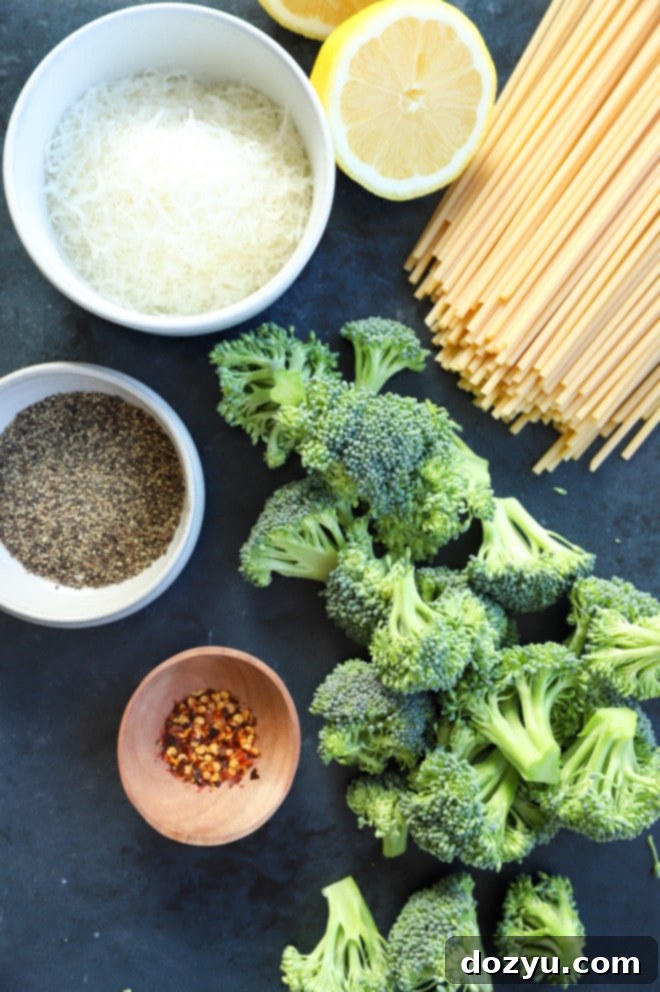
Essential Ingredients for a Perfect Cacio e Pepe
The magic of Cacio e Pepe, even with our broccoli addition, truly hinges on the quality and preparation of its core ingredients. Here’s a closer look at what you’ll need and why each element plays a crucial role:
- Broccoli: Fresh broccoli is highly recommended for its crisp texture and vibrant flavor. You’ll need about one medium head, cut into bite-sized florets. If you opt for frozen broccoli, ensure it’s completely thawed and pat it dry before tossing with the other ingredients to prevent excess moisture. Adjust roasting time to approximately 5 minutes for thawed frozen broccoli.
- Olive Oil: A good quality extra-virgin olive oil is essential for roasting the broccoli. Its fruity notes complement the other flavors and help achieve that perfect tender-crisp texture on the florets.
- Lemon Juice: Freshly squeezed lemon juice is a must. The bright acidity of lemon beautifully cuts through the richness of the cheese and pepper, adding a refreshing counterpoint to the roasted broccoli. Bottled lemon juice simply won’t deliver the same vibrant flavor.
- Red Pepper Flakes: These are optional, but I enthusiastically recommend them. A couple of pinches introduce a subtle, lingering heat that adds another layer of complexity to the dish without overpowering it. It’s a gentle warmth that enhances the peppery kick of the black pepper.
- Pasta: Bucatini is the star pasta for this recipe! Its distinctive hollow shape allows the creamy sauce to nestle both inside and around each strand, providing a truly unique and satisfying bite. If bucatini isn’t available or preferred, high-quality spaghetti or even a robust tube pasta like rigatoni can make an excellent substitute, though the experience will be slightly different.
- Butter: Use unsalted butter to control the overall saltiness of your dish. Butter adds a foundational richness and helps to “bloom” the pepper, extracting its aromatic oils and deep flavor. If you only have salted butter, be sure to significantly reduce the amount of salt added to your pasta water.
- Black Pepper: This is arguably the most crucial ingredient. Freshly cracked coarse black pepper is non-negotiable. Pre-ground, fine black pepper lacks the vibrant aroma and pungent kick that is characteristic of cacio e pepe. Invest in a good pepper mill and use whole peppercorns; the difference in flavor is truly astounding and makes all the difference in this minimalist dish.
- Cheese: The choice between Parmesan (Parmigiano-Reggiano) and Pecorino Romano is a matter of preference, and both yield delicious results. Pecorino Romano is the traditional choice, a sheep’s milk cheese with a sharper, saltier, and more pungent flavor profile. Parmesan, made from cow’s milk, offers a nuttier, slightly milder, and more subtle salty taste. Whichever you choose, ensure it is a high-quality, hard Italian cheese and, most importantly, finely grated fresh from the block. Pre-grated cheeses often contain anti-caking agents that can hinder the sauce’s emulsification, leading to a clumpy texture.
Kitchen Tools You’ll Need
Having the right tools on hand will make preparing this Bucatini Cacio e Pepe with Roasted Broccoli a seamless and enjoyable process. Here are the essential items:
- Chef’s Knife and Cutting Board: For efficiently breaking down the head of broccoli into uniform florets. A sharp knife makes this task quick and safe.
- Rimmed Half Sheet Baking Pan with Silicone Baking Mat or Parchment Paper: Ideal for roasting the broccoli evenly. The silicone mat or parchment paper prevents sticking and makes for easy cleanup, ensuring perfectly tender-crisp florets.
- Large Stockpot: Essential for boiling the pasta. A large pot allows enough water for the pasta to cook freely, preventing sticking and ensuring an even cook. Remember to generously salt the water, as this is your first layer of seasoning for the pasta and crucial for the sauce.
- Large Skillet or Sauté Pan: This is where the magic happens! A spacious skillet is needed to bloom the pepper and eventually toss and emulsify the pasta with the cheese and pasta water. Its wide surface area helps in creating a consistent, creamy sauce.
- Tongs: A versatile tool for tossing the roasted broccoli, transferring the cooked pasta from the pot to the skillet (while preserving that precious pasta water!), and mixing the pasta with the sauce. Look for sturdy tongs that offer a good grip.
- Cheese Grater: Absolutely vital for this recipe. You’ll need to finely grate your cheese fresh from the block. A microplane grater or the fine side of a box grater works best, as finely grated cheese melts more smoothly and incorporates better into the sauce, preventing clumps.
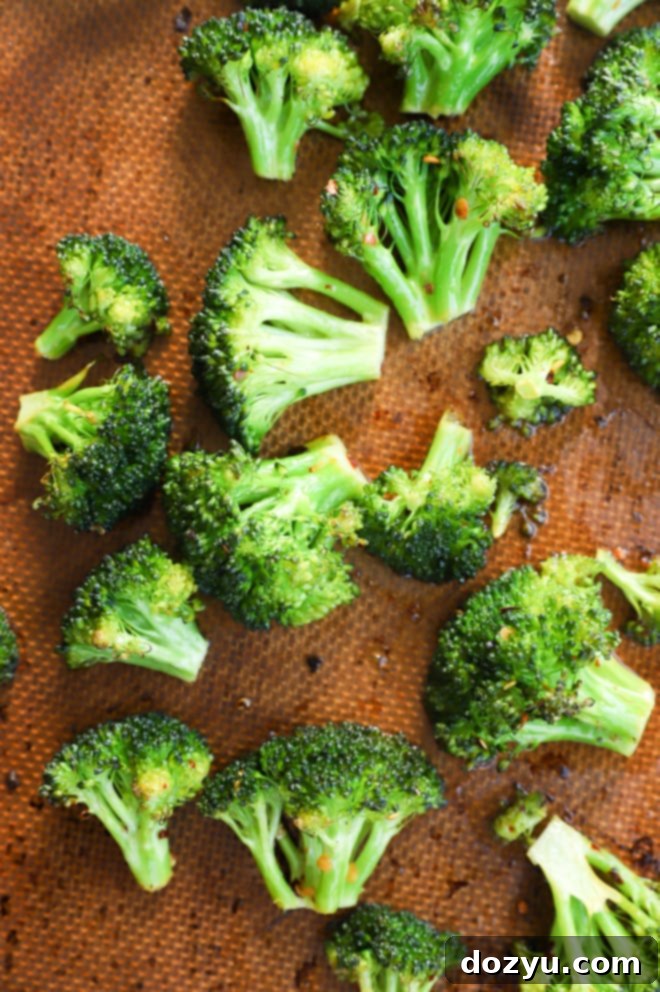
How to Make Bucatini Cacio e Pepe with Roasted Broccoli
Follow these steps closely to achieve a perfectly creamy and flavorful Bucatini Cacio e Pepe with Roasted Broccoli:
Roast the Broccoli
Begin by preheating your oven to 450˚F (232˚C). Line a baking sheet with a silicone mat or parchment paper for easy cleanup. In a large bowl, combine your fresh broccoli florets with olive oil, fresh lemon juice, and red pepper flakes. Season generously with salt and pepper, then toss everything together until the broccoli is evenly coated. Spread the seasoned broccoli out in a single layer on your prepared baking sheet. Roast for precisely 10 minutes until the florets are tender-crisp with slightly charred edges, indicating maximum flavor. Once roasted, remove from the oven and set aside; this will be folded into your pasta at the very end.
Cook the Pasta
While your broccoli is roasting, bring a large pot of generously salted water to a rolling boil. Remember, the pasta water is your primary seasoning for the pasta and a crucial ingredient for your sauce, so make it taste like the sea. Add the bucatini and cook until it is just al dente – this usually means about 2 minutes shy of the recommended cooking time on the package. The pasta should still have a firm bite, as it will continue to cook slightly when tossed with the hot sauce. Before draining, make sure to reserve at least 1 1/2 cups of the starchy pasta water! I find it easiest to remove the pasta from the pot using a pair of tongs, directly transferring it to the skillet, thereby ensuring I don’t accidentally dump out the precious pasta water.
Bloom the Pepper
While the pasta is cooking, prepare your sauce base. In a large skillet or sauté pan, melt the butter over medium heat. Once melted, add the freshly cracked black pepper. Cook the pepper for about 30 seconds, stirring constantly. This process, known as “blooming,” releases the essential oils and maximizes the pepper’s pungent aroma and flavor. Be careful not to burn the pepper. Immediately turn off the heat once bloomed and set the skillet aside; you want the pan to be warm, not searing hot, when the pasta and cheese are added.
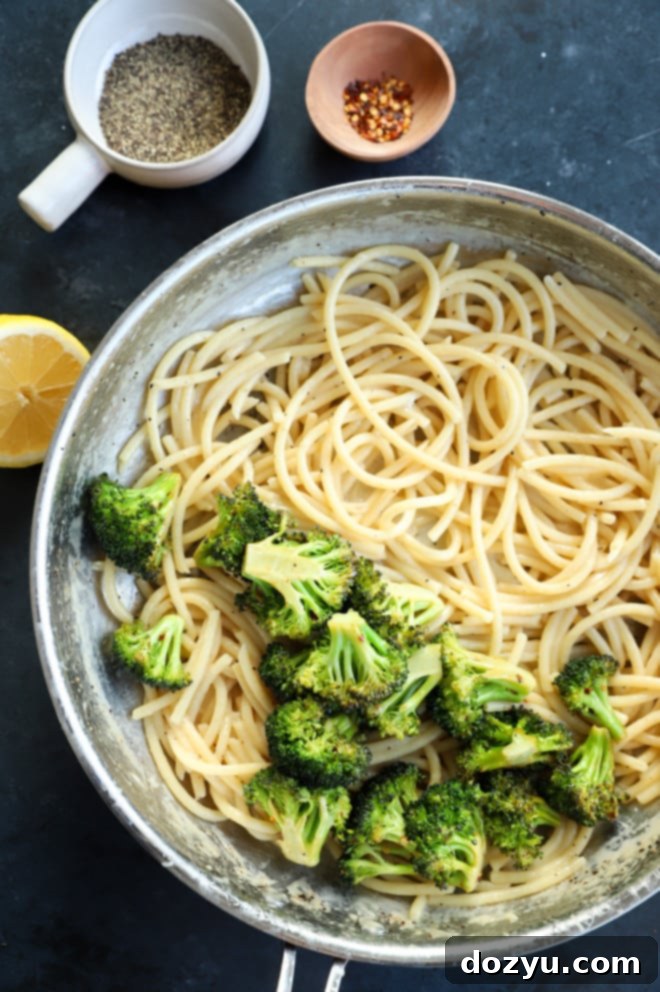
Finish and Serve
Add the cooked, al dente pasta directly into the large skillet with the melted butter and bloomed pepper. Pour in about 1/3 cup of the reserved starchy pasta water. Using tongs, vigorously toss the pasta to combine everything. Next, sprinkle in about a quarter of the finely grated Pecorino Romano or Parmesan cheese. Continue to toss the pasta, allowing the cheese to melt and emulsify with the pasta water and butter, forming a creamy sauce. The key here is to add the cheese in small increments, continuously tossing and waiting until each addition has fully melted and integrated before adding more. This gradual process prevents clumping and creates that signature smooth, glossy sauce. If the sauce becomes too thick, add an additional tablespoon or two of pasta water as needed, tossing until it reaches the perfect consistency. Finally, gently fold in the roasted broccoli florets. Serve the Bucatini Cacio e Pepe immediately, garnished with extra freshly ground black pepper and a generous sprinkle of additional grated cheese. Enjoy this extraordinary dish right away!
Expert Tips for Cacio e Pepe Success
Mastering Cacio e Pepe, though it seems simple, requires attention to a few key details. These tips will help you achieve that perfect, glossy, non-clumpy sauce every time:
- Bloom the Pepper: This step is non-negotiable for an authentic cacio e pepe flavor. Lightly toasting freshly cracked black pepper in butter (or olive oil, though butter is used here) awakens its essential oils, intensifying its aroma and taste. It brings out a deeper, more complex peppery note than simply adding raw pepper.
- Generously Salt the Pasta Water: Think of the pasta water as the foundation of your sauce and the first layer of seasoning for your pasta. It should be as salty as the sea. Not only does this flavor the pasta from the inside out, but the starchy, salty water is absolutely critical for creating the creamy emulsion with the cheese. Without enough salt, the cheese won’t melt smoothly into the sauce.
- Cook Pasta to Al Dente: It’s crucial not to overcook your pasta. Cook it until it’s just al dente, which means it still has a firm bite to it – typically 1-2 minutes less than the package instructions. The pasta will continue to cook and absorb flavor when tossed with the sauce in the skillet, ensuring it doesn’t become mushy.
- Finely Grate Your Cheese: This cannot be stressed enough. Use a microplane or the finest side of a box grater. Finely grated cheese melts more quickly and evenly, making it easier to emulsify into a smooth sauce. Coarsely grated cheese is far more prone to clumping.
- Add Cheese Incrementally: Never dump all the cheese into the pan at once! This is a common pitfall that leads to clumpy cheese. Add the finely grated cheese in small batches (quarter amounts work well), tossing vigorously after each addition. Allow the previous batch to melt and integrate before adding more. This controlled addition ensures a smooth, creamy sauce.
- Regulate Skillet Temperature: The skillet should be warm enough to melt the cheese but not so hot that it “shocks” the cheese, causing it to seize or clump. Turning off the heat after blooming the pepper and before adding the pasta helps achieve this ideal temperature. The residual heat from the pasta and the reserved water will be sufficient for melting and emulsifying.
- Vigorously Toss the Pasta: Don’t just stir. Use tongs to toss the pasta continuously and vigorously. This motion helps to create friction, release starch from the pasta, and combine the cheese, pepper, and pasta water into a beautiful, emulsified sauce. It’s a key part of forming that desired creamy consistency.
More easy pasta recipes to explore: Gochujang Noodles | Lemon Ricotta Pasta | 15-Minute Singapore Street Noodles | Instant Pot White Cheddar Mac and Cheese
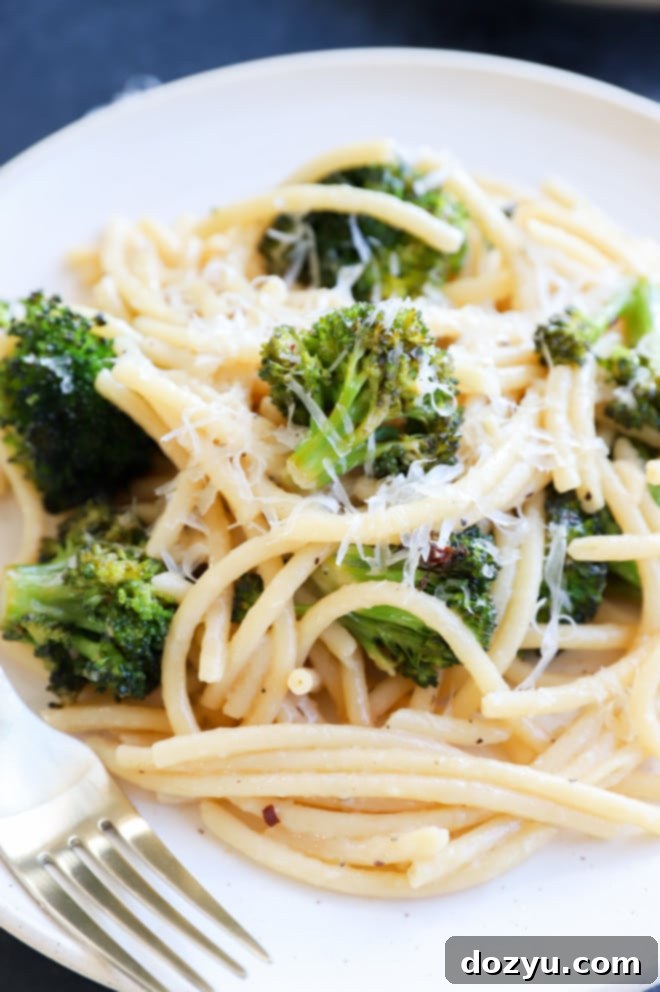
How to Prevent Cheese from Clumping?
Preventing the cheese from clumping is often the trickiest part of making Cacio e Pepe, but it’s entirely achievable with the right technique. Trust me, I’ve made plenty of clumpy messes in my learning process, usually when I’m rushing!
First and foremost, slow down. This recipe rewards patience. The primary reasons cheese clumps are rapid temperature changes and insufficient emulsification. Here’s how to avoid it:
- Freshly Grated, Fine Quality Cheese: This is paramount. Use high-quality Pecorino Romano or Parmesan and grate it yourself, fresh from the block. Pre-grated cheeses contain anti-caking agents (like cellulose) that prevent them from melting smoothly and can cause a grainy or clumpy texture. Most importantly, ensure the cheese is finely grated. A microplane is your best friend here. The finer the shreds, the quicker and more evenly they will melt and integrate into the sauce. Coarsely grated cheese takes too long to melt, increasing the risk of clumping.
- Control the Temperature: The pan should be warm, not scorching hot. After blooming the pepper, turn off the heat. The residual heat from the pan, combined with the hot pasta and hot starchy pasta water, will be enough to melt the cheese gently. If the pan is too hot, the cheese fats will separate, leading to a greasy, clumpy mess.
- Add Cheese Incrementally: This is perhaps the most crucial tip. Do not add all of the cheese at once. Instead, add the finely grated cheese in small increments (e.g., a quarter of the total amount at a time). After each addition, vigorously toss the pasta with tongs. This allows the cheese to gradually melt and combine with the starchy pasta water and butter, forming a smooth emulsion. By adding small amounts, there’s always more liquid (pasta water) than cheese, which encourages the cheese to dissolve into the sauce rather than clumping together.
- Vigorous Tossing and Enough Pasta Water: The constant, energetic tossing creates friction and releases starch from the pasta, which helps in binding the sauce. Ensure you have enough reserved pasta water; it’s the emulsifier. Add it gradually along with the cheese, allowing the sauce to come together with that perfect creamy, glossy consistency.
By following these steps, you’ll achieve a silky-smooth, perfectly emulsified Cacio e Pepe sauce every time.
Can I Use a Different Type of Pasta for Cacio e Pepe?
While bucatini is my absolute favorite for Cacio e Pepe due to its unique texture and ability to capture the creamy sauce both inside its hollow center and around its strands, you certainly can use other pasta shapes if bucatini isn’t available or preferred. The key is to choose a pasta that has some surface area or a shape that can hold the sauce well.
Spaghetti is the most common and excellent substitute for bucatini. Its long, thin strands are classic for Roman pasta dishes and allow the sauce to coat them beautifully. Other good options include:
- Rigatoni: Its ridged, tubular shape can really grab onto that creamy sauce.
- Penne: Similar to rigatoni, but smaller, also great for sauce adhesion.
- Tonnarelli: A fresh, square-cut spaghetti, very popular in Rome for Cacio e Pepe, offering a delightful chew.
Ultimately, the best pasta for you is one you enjoy eating, but for an authentic Roman experience, long pastas or sturdy short pastas are generally preferred.
Can I Make Cacio e Pepe Ahead of Time?
In my personal opinion, Cacio e Pepe is a dish that truly shines when served immediately after preparation. The creamy, emulsified sauce is at its peak of freshness, glossiness, and texture right off the stove. The pepper is vibrant, and the cheese is perfectly integrated. Therefore, I always recommend enjoying it right away if possible.
However, life happens, and sometimes leftovers are inevitable! This recipe doesn’t typically yield a massive amount, but if you do find yourself with some remaining, you can certainly store and reheat it. Just be aware that the sauce may lose some of its original creaminess and gloss, as it tends to thicken and the fats can separate upon cooling.
To store, place any leftovers in an airtight container and refrigerate for up to five days. While it won’t be quite the same as fresh, with a little care, you can still enjoy a delicious meal later. Find detailed reheating instructions below to help revive your pasta to its best possible state!
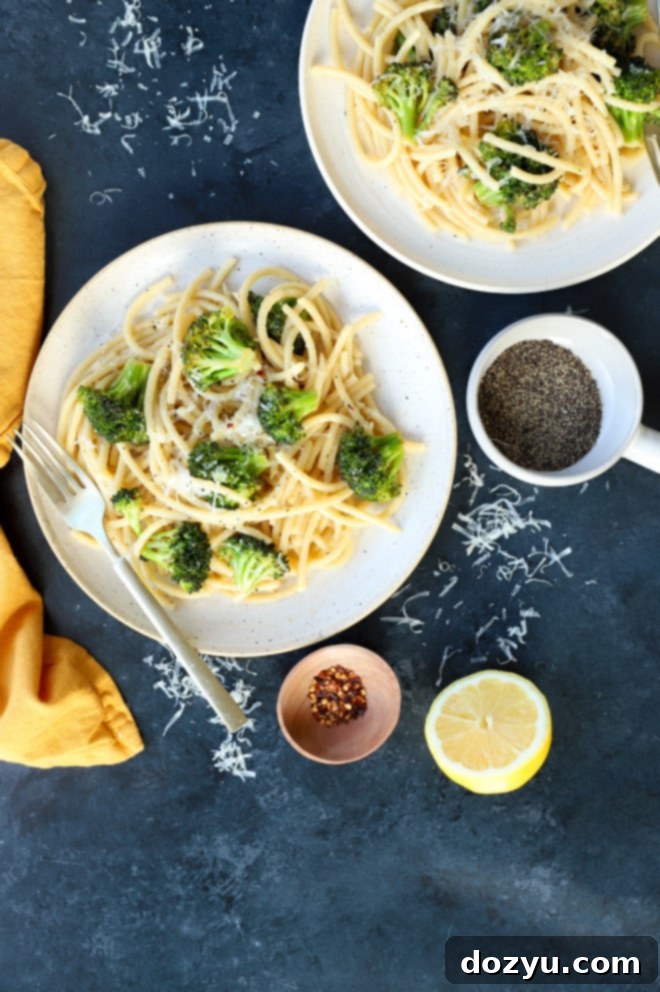
Pecorino Romano vs. Parmesan: Which Cheese is Best?
The choice between Pecorino Romano and Parmesan (Parmigiano-Reggiano) is a delicious dilemma, and truthfully, you can use either for this Bucatini Cacio e Pepe recipe! Both are excellent hard Italian cheeses that melt beautifully and provide the necessary salty, savory depth. The “best” choice often comes down to personal preference and how pronounced you want the cheese flavor to be.
Here’s a breakdown of their differences:
- Pecorino Romano: This is the traditional cheese used in authentic Roman Cacio e Pepe. It’s a hard, salty cheese made from sheep’s milk (pecora means sheep in Italian). It’s typically aged for a shorter period than Parmesan, which contributes to its more assertive, sharper, and more pungent flavor profile. If you love a bold, tangy, and distinctly salty cheese kick, Pecorino Romano is your go-to. It truly gives the dish that classic Roman edge.
- Parmesan (Parmigiano-Reggiano): Originating from the Emilia-Romagna region, Parmesan is made from cow’s milk and is aged for a much longer period (often 12-36 months). This extended aging process gives it a nuttier, fruitier, and slightly milder flavor compared to Pecorino Romano. It’s still salty and savory but has a more subtle complexity. If you prefer a less intense cheese flavor or want a more broadly appealing taste, Parmesan is an excellent choice.
Ultimately, both cheeses will create a fantastic, creamy sauce. If you want to lean into tradition and a stronger flavor, choose Pecorino Romano. If you prefer a milder, nuttier profile, Parmesan is perfect. Or, for a balanced approach, some chefs even like to use a blend of both!
My Pasta is Dry, What Should I Do?
If your Bucatini Cacio e Pepe ends up looking a bit dry or the sauce isn’t as lusciously creamy as you’d hoped, don’t panic! This is a common issue and usually easily fixable. The solution lies in your reserved pasta water.
The starch in the pasta water is the emulsifier that binds the cheese and pepper into a silky sauce. If your pasta appears dry, it likely means you either didn’t add enough pasta water initially, or the sauce has tightened up too much as it cooled slightly. Simply add a tablespoon or two of the hot reserved pasta water to the pan while continuously tossing the pasta with tongs. Repeat this process, adding small amounts and tossing vigorously, until the sauce reaches your desired creamy and glossy consistency. The key is to add it gradually and allow it to fully integrate before adding more. This will help to re-emulsify the sauce and bring it back to life.
My Pasta Sauce is Too Runny, How Do I Fix It?
Conversely, if your pasta is swimming in a sauce that’s too thin or watery, you’ve likely added too much pasta water or the emulsion hasn’t fully formed. This can also be remedied, though it requires a bit more care.
Return the skillet with the runny pasta to low heat. Gently let it simmer, continuously tossing the pasta. As it simmers, the excess moisture will evaporate, and the sauce will begin to thicken. The gentle heat and constant motion will encourage the cheese and starch to emulsify further. You can also try adding another small sprinkle of finely grated cheese and vigorously tossing, which will help absorb some of the liquid and thicken the sauce. While it might seem counterintuitive, sometimes adding another tablespoon of *starchy* pasta water while simmering can actually help bind the sauce further, allowing it to thicken as it continues to cook down slightly. The main goal is gentle heat and continuous agitation to encourage emulsification.
Need more inspiration for spring recipes? Check out my spring recipes page!
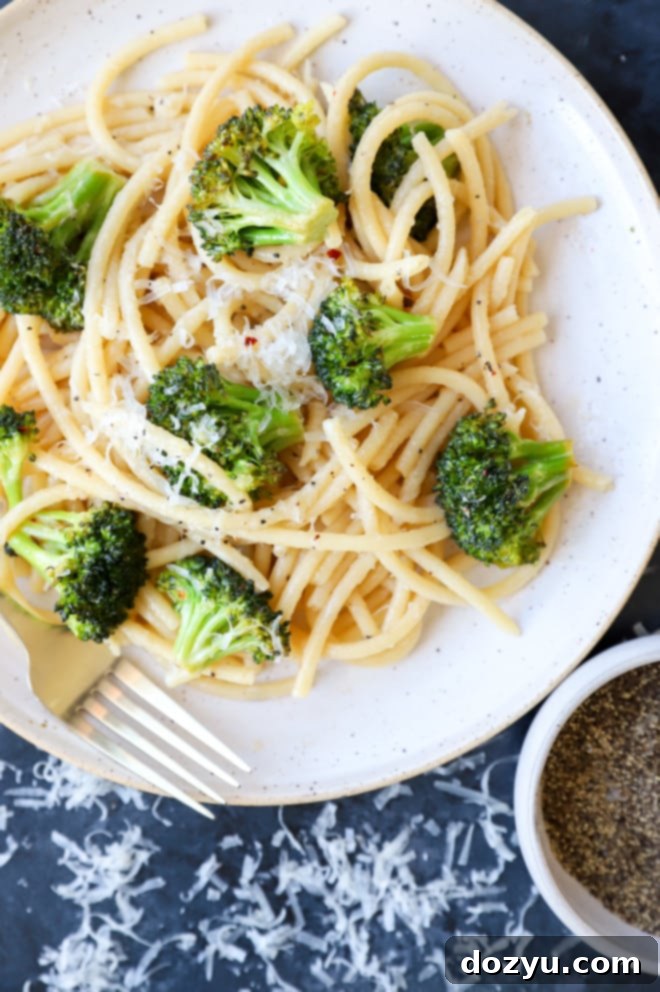
What to Serve with Bucatini Cacio e Pepe
Our Bucatini Cacio e Pepe with Roasted Broccoli is a wonderfully complete dish on its own, especially given the addition of fresh vegetables. It makes an excellent vegetarian main course, rich and satisfying enough for any meal. However, if you’re looking to round out your meal or add a protein, this versatile pasta pairs beautifully with a variety of complementary dishes. Here are some of my favorite suggestions:
- Roasted Chicken with White Wine and Fresh Herbs: For an effortlessly elegant meal, pair this pasta with my classic roasted chicken with white wine and fresh herbs. The savory, aromatic chicken offers a perfect counterpoint to the creamy pasta. Add a simple green salad with a light vinaigrette if you desire even more fresh vegetables.
- Balsamic Grilled Flank Steak: If you’re craving red meat, thinly sliced balsamic grilled flank steak served directly on top of the pasta creates a hearty and flavorful main dish. The tang of the balsamic glaze complements the peppery cheese beautifully.
- Air Fryer Scallops with Chive Lemon Butter: For a quick and delightful seafood option, serve simple and succulent air fryer scallops atop this pasta. You can either skip the chive lemon butter from the scallop recipe to let the cacio e pepe shine, or drizzle a little over for an extra layer of bright, herbaceous flavor.
- A Simple Green Salad: Sometimes, all you need is a fresh, crisp side to balance a rich pasta. A simple mixed green salad with a light lemon-herb vinaigrette would be perfect.
- Garlic Bread or Focaccia: For soaking up every last drop of that incredible sauce, a side of warm, crusty garlic bread or a slice of homemade focaccia is always a welcome addition.
- For Dessert: Keep it light and refreshing after such a flavorful meal. Something like an easy strawberry shortcake in a jar provides a sweet and bright finish without being overly heavy.
How to Store and Reheat Leftover Cacio e Pepe
While Cacio e Pepe is best enjoyed fresh, if you do have leftovers, here’s how to store and reheat them to maintain as much of their deliciousness as possible:
- Store: Allow any leftover pasta to cool completely to room temperature. Then, transfer it to an airtight container and store it in the refrigerator. It will keep well for up to 5 days.
- Reheat (Microwave): For individual servings, transfer the pasta to a microwave-safe dish. Add a splash of water (about 1-2 tablespoons) over the pasta. This is crucial for re-emulsifying the sauce and preventing it from drying out. Microwave on medium power for 1 minute, then stir well. Continue heating in 30-second intervals, stirring in between, until the pasta is warmed through and the sauce has returned to a creamy consistency. You may need to add another tiny splash of water if it seems dry.
- Reheat (Stovetop): For larger portions or if you prefer a more controlled reheating method, the stovetop is ideal. Place the leftover pasta in a saucepan or skillet over medium-low heat. Add a generous splash of water (2-4 tablespoons, depending on the amount of pasta) or even a bit of milk or cream to help revive the sauce. Stir continuously with tongs or a spatula, gently warming the pasta. The goal is to melt the cheese and re-emulsify the sauce without scorching it. Keep stirring until the pasta is hot and the sauce is creamy again, adding more liquid if it becomes too thick.
Remember that reheating might slightly alter the texture of the pasta and the sauce, but with these tips, you can still enjoy a very tasty meal!
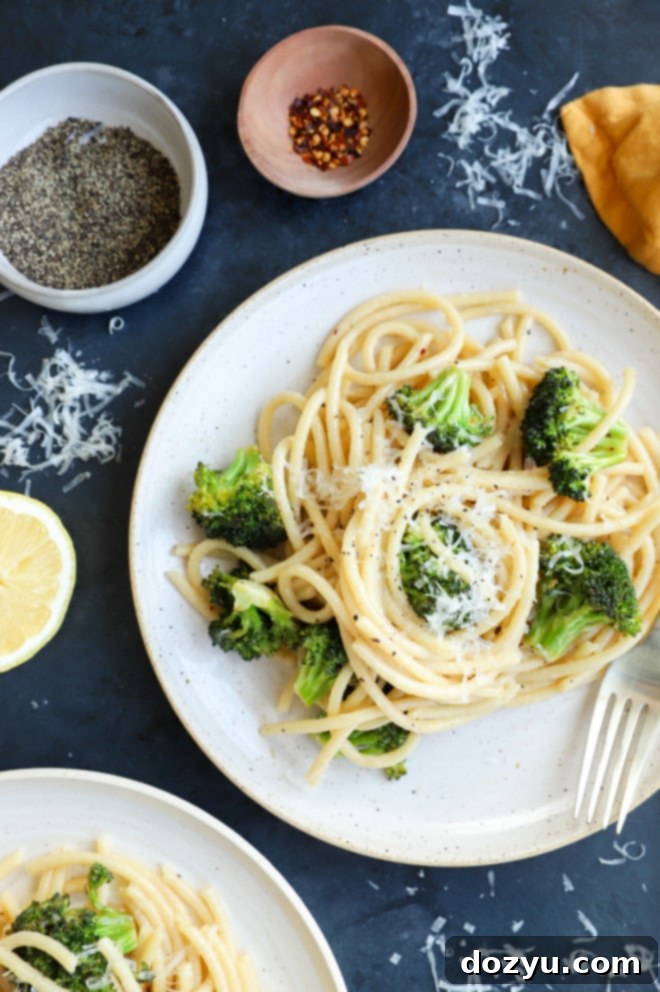
Finally, if you fall in love with this Bucatini Cacio e Pepe with Roasted Broccoli recipe as much as I have, please consider giving it a rating or leaving a comment below! Your feedback means the world to me, and I always take the time to respond to every single one. Feel free to drop any questions you might have about the recipe too – I’m here to help.
And of course, don’t forget to tag me on Instagram (@cakenknife) if you share your culinary creations! There’s nothing I love more than seeing these recipes come to life in your kitchens. It truly warms my heart to see your delicious results!
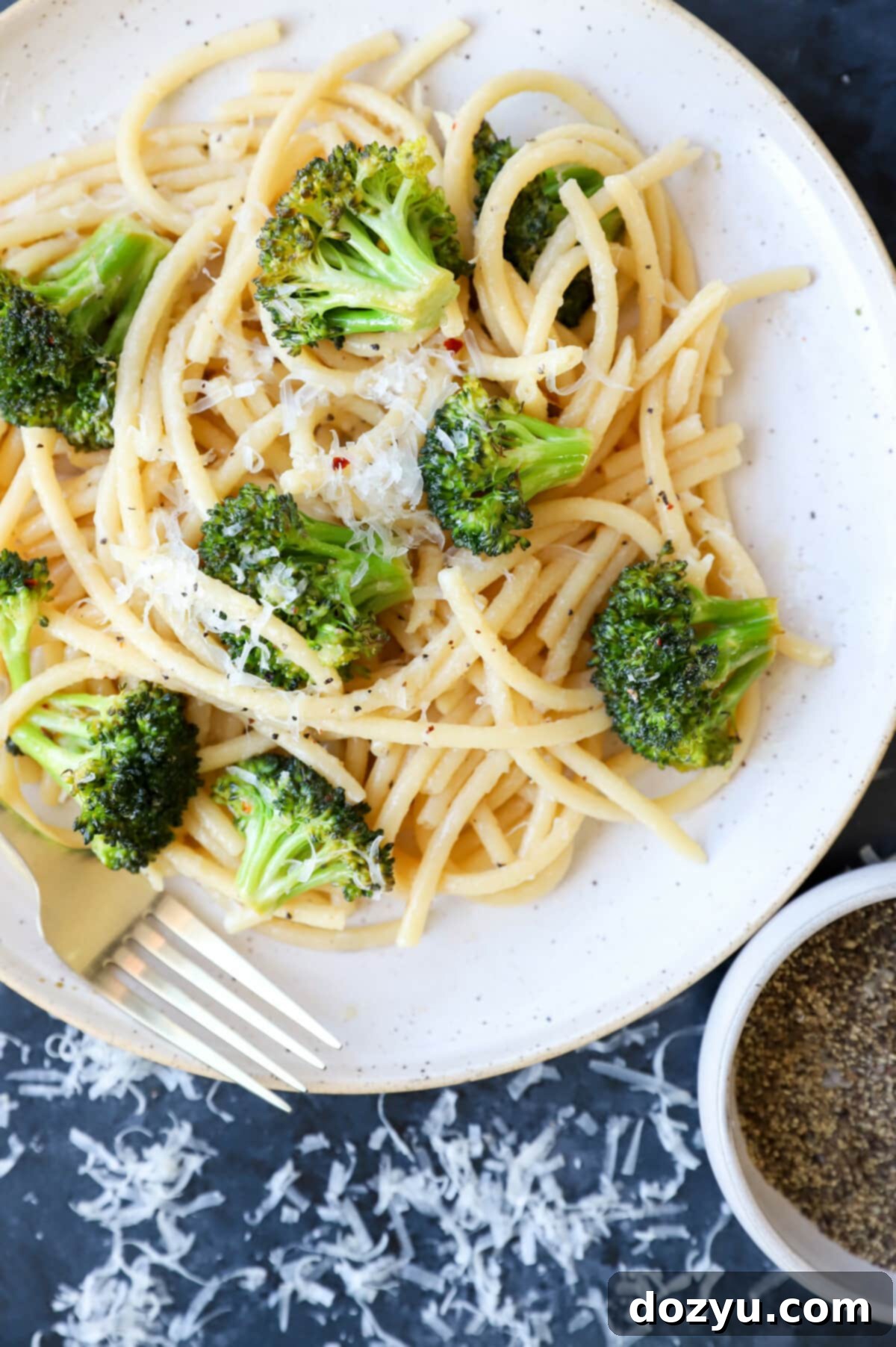
Bucatini Cacio e Pepe with Broccoli Recipe Card
Equipment
-
Shun Chef’s Knife
-
Organic Bamboo Cutting Board
-
9-Inch Tongs
-
Nonstick 12-Inch Skillet
Ingredients for Bucatini Cacio e Pepe with Broccoli
- 1 bunch fresh broccoli cut into florets (approx. 1-2” in length)
- 2 Tbsp extra-virgin olive oil
- 1 Tbsp fresh lemon juice
- 2 pinches red pepper flakes (optional)
- Salt and freshly ground black pepper to taste
- 8 oz uncooked bucatini (or spaghetti)
- 2 Tbsp unsalted butter
- 1 tsp freshly-ground coarse black pepper (more to taste)
- 2 oz finely-grated Pecorino Romano cheese (or Parmesan, fresh from the block)
Instructions for Bucatini Cacio e Pepe with Broccoli
-
Preheat your oven to 450˚F (232˚C). Line a baking sheet with a silicone mat or parchment paper.
-
In a large bowl, combine the broccoli florets with olive oil, lemon juice, and red pepper flakes. Season with salt and pepper, then toss thoroughly to ensure even coating. Spread the seasoned broccoli in a single layer on the prepared baking sheet.
-
Roast the broccoli for 10 minutes, or until tender-crisp and lightly charred. Remove from the oven and set aside.
-
While the broccoli roasts, bring a large pot of generously salted water to a boil over high heat. Once boiling, add the bucatini and cook until it is just al dente (typically 1-2 minutes less than the package instructions).
-
While the pasta cooks, prepare your sauce base: melt the unsalted butter in a large skillet over medium heat. Add the freshly ground black pepper and cook for about 30 seconds, stirring constantly, to allow the pepper to bloom and release its flavors. Immediately turn off the heat and set the skillet aside.
-
Once the pasta is al dente, use tongs to transfer it directly to the skillet with the melted butter and pepper. Do NOT drain the pasta water! Add 1/3 cup of the reserved pasta water to the pan and vigorously toss the pasta to combine.
-
Sprinkle over a quarter of the finely grated Pecorino Romano (or Parmesan) cheese. Toss the pasta continuously until the cheese has completely melted and incorporated into a creamy sauce. Add the remaining cheese in small increments, tossing thoroughly after each addition until a smooth, glossy sauce forms.
-
If the sauce appears too thick, add a few extra tablespoons of reserved pasta water as needed, tossing to achieve the desired creamy consistency.
-
Gently fold in the roasted broccoli florets. Serve the pasta immediately with extra freshly ground black pepper and additional freshly grated cheese, if desired. Enjoy right away for the best experience!
